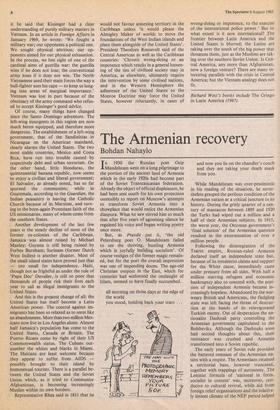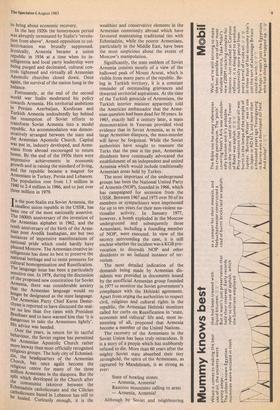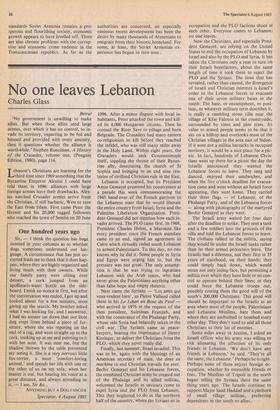The Armenian recovery
Bohdan Nahaylo
In 1930 the Russian poet Osip Mandelstam went on a long pilgrimage to the portion of the ancient land of Armenia which in the early 1920s had become part of the Soviet Transcaucasian federation. Already the object of official displeasure, he had been sent south for his own protection ostensibly to report on Moscow's attempts to transform Soviet Armenia into a showplace that would entice the Armenian diaspora. What he saw stirred him so much that after five years of agonising silence he regained his voice and began writing poetry once more.
But, as Pravda put it, 'the old Petersburg poet 0. Mandelstam failed to see the thriving, bustling Armenia which is joyfully building socialism'. Of course vestiges of the former magic remain- ed, but for the poet the overall impression was one of impending doom. The age-old Christian outpost in the East, which for centuries had withstood the onslaught of Islam, seemed to have finally succumbed.
all morning on those days at the edge of the world you stood, holding back your tears . and now you lie on the chandler's couch and they are taking your death mask from you.
While Mandelstam was over-pessimistic in his reading of the situation, he never- theless grasped the perilous condition of the Armenian nation at a critical juncture in its history. During the grisly quarter of a cen- tury of massacres between 1895 and 1920 the Turks had wiped out a million and a half of their Armenian subjects. In 1915, the worst year, the Ottoman government's final solution' of the Armenian question resulted in the extermination of over a million people.
Following the disintegration of the Tsarist empire, Russian-ruled Armenia declared itself an independent state but, because of its irredentist claims and support for the White cause, immediately came under pressure from all sides. With half a million starving refugees and economic bankruptcy also to contend with, the posi- tion of independent Armenia became in- creasingly hopeless. Abandoned by the war- weary British and Americans, the fledgling state was left facing the threat of destruc- tion at the hands of its reinvigorated Turkish enemy. Out of desperation the na- tionalist Dashnak party controlling the Armenian government capitulated to the Bolsheviks. Although the Dashnaks soon had second thoughts about this, their resistance was crushed and Armenia transformed into a Soviet republic.
The early years of Soviet rule provided the battered remnant of the Armenian na- tion with a respite. The Armenians retained a territorial base, however truncated, together with trappings of autonomy. The Leninist formula of 'national in form, socialist in content' was, moreover, con- ducive to cultural revival, while aid from foreign relief organisations and the relative- ly lenient climate of the NEP period helped to bring about economic recovery.
In the late 1920s the honeymoon period was abruptly terminated by Stalin's 'revolu- tion from above'. Armed opposition to col- lectivisation was brutally suppressed. Ironically, Armenia became a union republic in 1936 at a time when its in- telligentsia and local party leadership were being purged and decimated, cultural con- trols tightened and virtually all Armenian Apostolic churches closed down. Once again, the survival of the nation hung in the balance.
Fortunately, at the end of the second world war Stalin moderated his policy towards Armenia. His territorial ambitions in Persian Azerbaijan, Kurdistan and Turkish Armenia undoubtedly lay behind the resumption of Soviet efforts to transform Soviet Armenia into a model republic. An accommodation was demon- stratively arranged between the state and the Armenian Apostolic Church. Capital was put in, industry developed, and Arme- nians from abroad encouraged to return home. By the end of the 1950s there were impressive achievements in economic growth and in raising the standard of living, and the republic became a magnet for Armenians in Turkey, Persia and Lebanon. The population rose from 1.3 million in 1940 to 2.4 million in 1966, and to just over three million in 1979.
In the post-Stalin era Soviet Armenia, the smallest union republic in the USSR, has been one of the most nationally assertive. The 1600th anniversary of the invention of the Armenian alphabet in 1962, and the tenth anniversary of the birth of the Arme- nian poet Avedik Issahagian, are but two instances of impressive manifestations of national pride which could hardly have Pleased Moscow. The Armenian creative in- telligentsia has done its best to preserve the national heritage and to resist pressures for cultural homogenisation and Russification. The language issue has been a particularly sensitive one. In 1978, during the discussion of the proposed new constitution for Soviet Armenia, there was considerable anxiety that the Armenian language would no longer be designated as the state language. The Armenian Party Chief Karen Demir- chYan is reported to have discussed the mat- ter no less than five times with President Brezhnev and to have warned him that 'it is dangerous to take the Armenians lightly'. His advice was heeded. Over the years, in return for its tactful behaviour, the Soviet regime has permitted the Armenian Apostolic Church rather more leeway than most officially recognised religious groups. The holy city of Echmiad- zin, the headquarters of the Armenian Church, has once again become the religious centre for many of the three million Armenians in the diaspora. But the split which developed in the Church after the communist takeover between the Echmiadzin catholicosate and the Cilician catholicosate based in Lebanon has still to be healed. Curiously enough, it is the
wealthier and conservative elements in the Armenian community abroad which have favoured maintaining traditional ties with Echmiadzin, while the poorer Armenians, particularly in the Middle East, have been the most suspicious about the extent of Moscow's manipulation.
Significantly, the state emblem of Soviet Armenia consists mostly of a view of the hallowed peak of Mount Ararat, which is visible from many parts of the republic. Be- ing in Turkish territory, it is a constant reminder of outstanding grievances and thwarted territorial aspirations. At the time of the Turkish genocide of Armenians, the Turkish interior minister apparently told the American ambassador that the Arme- nian question had been dead for 50 years. In 1965, exactly half a century later, a mass demonstration in Yerevan provided vivid evidence that in Soviet Armenia, as in the large Armenian diaspora, the mass-murder will never be forgotten. While the Soviet authorities have sought to reassure the Turks that the past is the past, Armenian dissidents have continually advocated the establishment of an independent and united Armenia which would include traditionally Armenian areas held by Turkey.
The most important of the underground groups has been the National United Party of Armenia (NOP), founded in 1966, which has campaigned for secession from the USSR. Between 1967 and 1975 over 50 of its members or sympathisers were imprisoned for up to ten years for their non-violent na- tionalist activity. In January 1977, however, a bomb exploded in the Moscow underground and subsequently three Armenians, including a founding member of NOP, were executed. In view of the secrecy surrounding the case, it is still unclear whether the incident was a KGB pro- vocation to discredit NOP and other dissidents or an isolated instance of ter- rorism.
The most detailed indication of the demands being made by Armenian dis- sidents was provided in documents issued by the unofficial Armenian group founded in 1977 to monitor the Soviet government's compliance with the Helsinki agreement. Apart from urging the authorities to respect civil, religious and cultural rights in the republic, the Armenian Helsinki monitors called for curbs on Russification in 'state, economic and cultural' life and, most in- teresting of all, proposed that Armenia become a member of the United Nations.
The recovery of the Armenians in the Soviet Union has been truly miraculous. It is a story of a people which has stubbornly refused to die. More than 60 years after the mighty Soviet state absorbed their tiny
stronghold, the spirit of the Armenians, as captured by Mandelstam, is as strong as ever: State of howling stones — Armenia, Armenia! Raucous mountains calling to arms — Armenia, Armenia!
Although by Soviet and neighbouring standards Soviet Armenia remains a pro- sperous and flourishing society, economic growth appears to have levelled off. There are also chronic problems with the corrup- tion and economic crime endemic in the Transcaucasian republics. As far as the authorities are concerned, an especially ominous recent development has been the desire by many thousands of Armenians to emigrate from their historic homeland. For some, at least, the Soviet Armenian ex- perience has begun to turn sour.








































 Previous page
Previous page